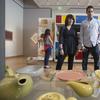Exalted Nature: The Real and Fantastic World of Charles Burchfield
- CHADDS FORD, Pennsylvania
- /
- June 22, 2014

The vibrant, visionary landscapes of Charles Burchfield (1893-1976), one of the leading American artists of the 20th century, are featured in a major exhibition of more than 50 paintings on view at the Brandywine River Museum of Art from August 23 through November 16, 2014. Co-organized by the Brandywine River Museum of Art and the Burchfield Penney Art Center, Buffalo, the exhibition features works borrowed from museums and private collections across the United States, including the Burchfield Penney Art Center, the largest repository of the artist's work. A fully illustrated catalogue will accompany the exhibition, with essays by the co-curators, Audrey Lewis, associate curator at the Brandywine, and Nancy Weekly, head of collections and Charles Cary Rumsey Curator at the Burchfield Penney.
Exalted Nature: The Real and Fantastic World of Charles Burchfield will provide a remarkable opportunity to examine the artist's luminous, personal interpretations of the world around him. "To spend even a moment with one of Charles Burchfield's hallucinatory watercolors is to experience the artist's visceral response to nature. Over a period of six decades, he explored the lyrical and technical potential of watercolor, becoming one of the most brilliant practitioners in the history of American art," said Thomas Padon, director of the Brandywine River Museum of Art.
A native of Ohio who spent much of his career in Buffalo, Burchfield was enthralled by the countryside from childhood, keeping detailed journal accounts of his observations and emotional reactions to his surroundings, a practice he continued throughout his life and which carried over into his paintings.
Vibrant with color, light and movement, his landscapes combine the real and fantastic, reflecting his immersion in the natural world and his response to the forces of nature. Burchfield infused his paintings with sensory reactions to the ephemeral effects of light, the sights and sounds of the weather, the seasons, the call of birds and the hum of insects. In 1915, he wrote "It seems at times I should be a composer of sounds, not only of rhythms and colors. Walking under the trees, I felt as if the color made sound."
Exalted Nature will span the breadth of the artist's career, tightly focused on his landscapes--from his early expressionistic compositions influenced by modernist movements first encountered during his student years at the Cleveland School of Art--such as Untitled (Gothic Window Trees), 1918--to his late visionary works representing his singular interpretation of the world--including Bee Hepaticas (circa 1962).
Other highlights include Midsummer Caprice(1945), which beautifully conveys how the artist used visual devices and motifs to suggest sounds and movement in nature. Burchfield was fascinated with the noisy cicada throughout his career and makes the insect the focal point of the painting, exaggerating its scale and surrounding it with repetitive, curved lines to convey the thundering reverberation of its sound.
About this same time (the 1940s), Burchfield began reconstructing some of his early work--by pasting additional paper onto the margins and painting out to those new edges--in order to reconsider and re-explore themes that continued to move him, pushing his work to another level in which his visionary approach was predominant. These reconstructions were larger, louder and more complex than his previous work. Nighthawks at Twilight was begun in 1917 and revisited in 1949, when the artist enlarged it to 34 3/8 x 48 1/2 inches. Twilight was a particularly compelling time of day for Burchfield--he exulted in such transitory moments, whether it was from day to night or one season to the next. In this painting he creates an eerie and darkly foreboding atmosphere, making visceral the strength of the wind through the grass, flowers and trees, all bending, contrasted with the tree tops in dramatic silhouette, like lace, against the threatening sky. The misshapen clouds and nighthawks crowding the sky further heighten the sense of deep apprehension.
One of Burchfield's last paintings, still on his easel at the time of his death in early 1967, is Early Spring, depicting the landscape around his home in Gardenville, New York (near Buffalo), where he had settled in the 1920s. The transition from winter to spring was one of his favorite themes. In this painting, Burchfield projects a mystical, dreamlike quality through the blurring of details of the flowers, treetops and sky. A luminous yellow halo line surrounds the tightly grouped trees recalling the nave of a cathedral and suggesting the spirituality that the artist found in nature. Spring always carried with it, for Burchfield, a sense of hope and sorrow--hope because spring represented renewal, sorrow because of the fleeting quality of its beauty.
This exhibition marks the first time Burchfield's work has been shown at the Brandywine River Museum of Art. A slate of multi-disciplinary events, lectures and other programs will take place during the run of the exhibition; for details, please visit the museum's website.
For information, please call 610.388.2700 or visit brandywine.org.







100x100_c.jpg)








